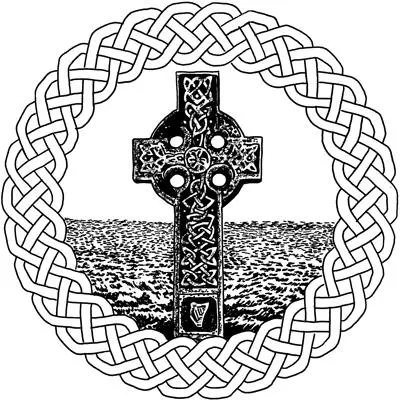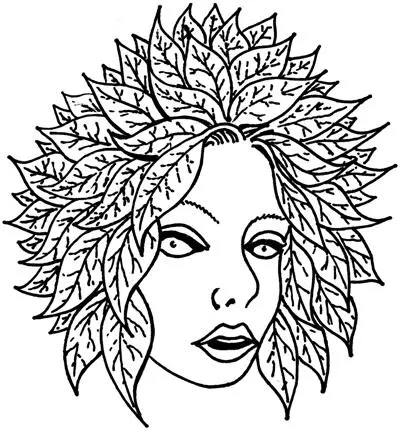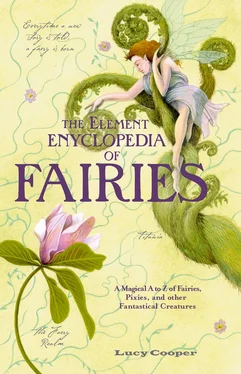She is the guardian spirit of deer, which she herds, milks, and protects from hunters. She is a friend to wild cattle, swine, and wolves, and sometimes assumes the shape of a wild boar. She is also a guardian of wells and streams.
One story concerning the creation of Loch Awe in Scotland, recounts how, tired after a long day herding her deer, Cailleach Bheur fell asleep while watching over a well. The well overflowed and water poured down the mountains and flooded the valley below, forming first a river and then the loch.
(Pronounced cait shee. ) Fairy cat of the Scottish Highlands. Believed by some to be a witch transformed into a cat rather than a fairy, the cait sith is described in J. G. Campbell’s Superstitions of the Highlands and Islands of Scotland (1900) as being black with a white spot on its breast, the size of a dog. When angry, it arches its back and bristles its fur.
After a death, Scottish Highlanders would keep watch over the body to prevent the cait sith from coming near it. They believed that the fairy cat could steal the soul from a corpse by jumping over it before the burial. Games, riddles, music, and wrestling took place at the watches, called Feill Fadalach (Late Wakes), which were designed to distract the cait sith and protect the soul of the recently deceased.
Campbell, John Francis (1821–1885)
Author of one of the most famous collections of Scottish folk tales, John Francis Campbell was born in Edinburgh, but brought up on the island of Islay (Inner Hebrides). The island had belonged to his family since the eighteenth century; he was also known as Campbell of Islay. His upbringing was unusual in that he was allowed to mix with the local children. This was rather unconventional at a time when social etiquette required everyone to keep to a strict code of conduct and “know their place.” He said of his education:
As soon as I was out of the hands of nursemaids I was handed over to the care of a piper. His name was the same as mine, John Campbell, and from him I learned a good many useful arts. I learned to be hardy and healthy and I learned Gaelic; I learned to swim and to take care of myself, and to talk to everybody who chose to talk to me. My kilted nurse and I were always walking about in foul weather or fair, and every man, woman, and child in the place had something to say to us. Thus I made early acquaintance with a blind fiddler who could recite stories. I worked with the carpenters; I played shinty with all the boys about the farm; and so I got to know a good deal about the ways of the Highlanders by growing up as a Highlander myself.
He was educated at Eton and at Edinburgh University, where he studied geology and photography. He later invented an instrument to record sunshine hours that is still in use today.
His interest in local folk tales was rekindled when one of his close friends returned from Stockholm, having met Jakob Grimmthere. He was persuaded to collect tales from the Highlands and islands of Scotland and trained a team of Gaelic speakers who collected 800 stories. His Popular Tales of the West Highlands, Orally Collected (in four volumes) was published between 1860 and 1862.

Campbell, John Gregorson (1836–1891)
A collector of tales and traditions from the Scottish Highlands, J. G. Campbell pursued the same method of collection as J. F. Campbell, recording tales directly from Gaelic speakers, which were later translated into English.
Campbell was born in Argyllshire, Scotland, and was first educated at the local school in Appin, where the family moved when he was three years old. His further schooling was in Glasgow, where he later attended the Andersonian University. While at university his passion for traditional tales grew and he met many storytellers and committed their tales to memory.
Campbell continued his studies and read law, but his inclination was toward the Church and he was licensed by the Presbytery of Glasgow in 1858. He continued to be a keen collector of stories. These were eventually compiled in Superstitions of the Highlands and Islands of Scotland and Witchcraft and Second Sight in the Highlands and Islands of Scotland and were published posthumously in 1900 and 1902 respectively.

Native American tree spirits, literally meaning “they live in a tree.” From the mythology of the Lakota of North and South Dakota.
(Pronounced konyack. ) Meaning “weeper,” caoineag is one of the names of the Scottish banshee. Her wail, heard in the darkness at a waterfall, heralds catastrophe for the clan. She is heard, but never seen. Unlike the bean nighe , she can’t be approached to grant wishes.

(Pronounced kondyuch .) Meaning “wailer,” the caointeach is another version of the caointeag , the Scottish banshee. She is local to Argyllshire, Skye, and the neighboring islands. She has a particularly lamentable and loud cry that rises almost to a scream. In appearance, she has been described as a very little woman or child wearing a high-crowned white hat, short green gown, and petticoat. She sometimes beats clothes on a rock, like the bean nighe .
James Macdougall and George Calder’s Folk Tales and Fairy Lore (1910) relates the story of the caointeach who followed the MacKay clan. When a death was going to take place, she would call at the sick person’s house with a green shawl around her shoulders and warn the family by wailing sadly outside his door. When the friends and family heard her lament, they lost all hope of the sick person getting better, for it was proof that the end was near.
The caointeach has ceased to give warning to the MacKays since one wet, cold, winter night, when she stood softly wailing outside a house and a member of the family took pity on her and offered her a plaid (blanket). She accepted the gift, but in the same way as when a brownieaccepts a gift of clothes his spirit is “laid,” or set free, so too the caointeach has never come back to mourn for the MacKays.
In Westmorland, northwest England (now part of Cumbria), there was once a barn called Capelthwaite Barn, in which the Capelthwaite made its home. He was said to be able to assume any form at will, but his preferred shape was that of a black dog the size of a calf. He was friendly toward the owners of the barn, and helped them by rounding up their sheep and cows. However, when it came to strangers, he showed a mischievous and spiteful streak. In the end, the vicar of Beetham performed a ceremony and “laid” this supernatural black dog in the river Bela. It was not seen again, except for in one tale related in William Henderson’s Notes on the Folklore of the Northern Counties of England and the Borders (1866), when a man returning from the local fair somewhat disheveled, without his cap or coat, persisted in blaming the Capelthwaite for his misadventure, telling his wife that the Capelthwaite had chased him and thrown him into the hedge.
Читать дальше















